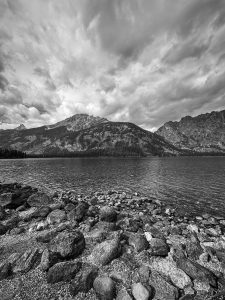Where the Buffalo Roam, And One Can’t Doomscroll
In the spring of 1942, landscape photographer Ansel Adams stood on the roof of his Pontiac with its wood-paneled doors, peering into his 8×10 view camera, mounted on a tripod with its lens aimed at the craggy peaks of Wyoming’s Grand Tetons. The Snake River formed an S-curve below. In his photograph, the peaks were nearly covered in snow above the timberline, as they were when we briefly visited in mid-October.
I stood next to an outdoor display of his photographs at the site where Ansel made his famous image of the Tetons and Snake River. Of course, I attempted to create my own highly inferior version of his photo. In the 82 years since Adams made the photograph, the lodgepole pines have grown up to obscure a piece of Snake River. Regardless, it felt magical to stand in this beautiful spot memorialized by one of my photographic heroes.
Our route to this spot first took us from Cody, Wyoming through Yellowstone National Park. Tourist tip: Mid-October is the perfect time to visit these parks, but do not wait much later as most park roads close on Nov. 1. While the aspens at higher elevations have already shed their leaves, the parks have also shed most of the crushing crowds of summer. Even the site of Old Faithful, the iconic cone geyser that erupts on such a reliable schedule that park rangers post signs announcing the next event, was relatively uncrowded. About 90% of the park’s eruption predictions of Old Faithful occur within a window of 10 minutes.
Yellowstone, our nation’s first national park, contains nearly 500 geysers – about half of the world’s active geysers. The area around Old Faithful contains several geysers. Signs sternly warn visit ors to say on the designated trail or risk serious injury and even death. More than 20 park visitors and a number of dogs have died from being scalded by geysers, whose waters reach as much as 250 degrees. We stayed on the trails and left the dogs at home. Old Faithful erupted at the appointed hour, impressive indeed.
ors to say on the designated trail or risk serious injury and even death. More than 20 park visitors and a number of dogs have died from being scalded by geysers, whose waters reach as much as 250 degrees. We stayed on the trails and left the dogs at home. Old Faithful erupted at the appointed hour, impressive indeed.
Here’s another tourist tip for readers 62 or older. The National Park Service sells a lifetime senior pass called American the Beautiful for $80 that gets one into any national park or federal recreation site. I bought such a pass in January 2020, as we had booked a trip to Yellowstone and Grand Teton for May of that year. You might recall – sadly, too many of us have selective amnesia – the COVID-19 pandemic arrived in March that year. We canceled that trip, which is why we have finally arrived in the West in October 2024. Since each park charges $35 to enter, we have nearly recouped our original $80 expense. There are plenty more national parks on our bucket list in years to come.
Back to the Grand Tetons, which ring the valley called Jackson Hole, widely known as a recreational playground for the seriously wealthy, where the average listing price for a single-family home is more than $7 million. Needless to say, we didn’t browse the real estate listings.
But you do not have to be rich to visit. The national parks belong to all of us. During our two days in the two parks, we got a taste of what they have to offer – pronghorns bounding in a meadow, a herd of bison grazing, an elk cow fleeing a group of tourists armed with cameras, a lone wolf gazing at us from the highway. And the scenery, postcard perfect.
We are already talking about a return trip once winter ends and the park roads are clear and open. It certainly helps take one’s mind off our nation’s travails, at least for a little while – especially when there is not cell service, no FM station within earshot, no way to doomscroll as we meander the highway. That was certainly a blessing.
America the Beautiful indeed.
Leave a reply
Fields marked with * are required











